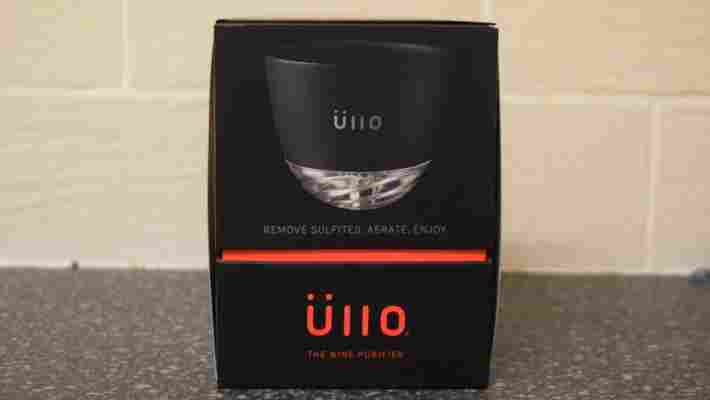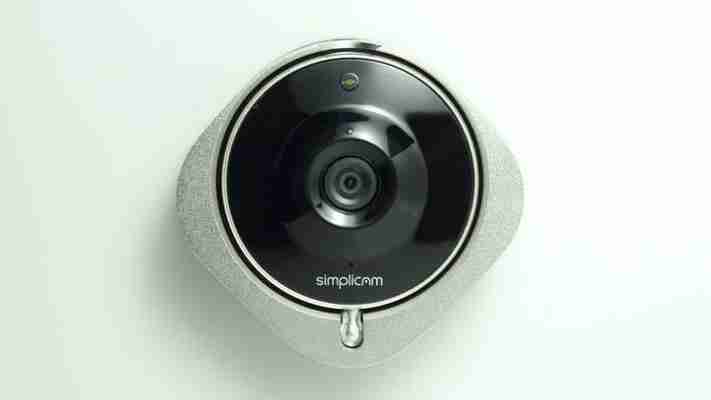Once upon a time, a Jewish carpenter did the impossible and turned a few pails of water into a bountiful supply of Palestine’s finest vintage vino. Two millennia later, one Chicago company is doing their own merlot-related miracles.

Üllo is a startup with a mission that I can totally get behind – to make even the grossest, nastiest, cheapest box wine taste half-decent. To achieve this goal, it’s built a filtration device that costs $79.99, and both aerates and removes sulphites.
And you know what? It actually works.
Üllo vs dreadful British wine
There are lots of reviews that pit Üllo against all ranges of the wine world, from humdrum $10 bottles, to ones that cost significantly more. I wanted to see how it’d cope with the ultimate bargain-basement wine.
Apparently British wine is a thing. I visited my local ASDA (Britain’s ersatz version of Wal-Mart) and picked up a bottle of Three Mills Reserve, which cost me the princely sum of £3.50 (around $5). Hey big spender.
First, I drank a control glass. Y’know. For science. Here’s how Three Mills describes itself:
Ha.
I didn’t have high hopes, but even those were betrayed. I’m not a sommelier, but I can tell when a bottle of wine is shit. This was shit.
For starters, it failed the sniff-test, producing something faintly reminiscent of burned tires and abject misery.
It turns out that ‘Three Mills’ is a pretty apt name for an over-sweet syrup that could quite easily be the by-product of an industrial accident. Perhaps a head-on collision between two tankers; one containing aspartame, and one containing a vast quantity industrial waste. I don’t want to labor the point too much, but this tasted bad .
Could the Üllo do the impossible and make this taste any less cloying and unpleasant?
As a device, the Üllo is pretty simple. The purifier consists of just three parts; there’s a rubber bowl which you pour the wine into, and clings to the sides of the glass; then there’s a bit that holds the filter in place; finally there’s a removable aerating device.
You turn aeration on and off as you desire, and the purifier can be assembled and disassembled it in just a short minute.
Also included is a sleek little travel bag, plus four filters. When you (inevitably) run out of them, you can restock on the Üllo site. A six-pack will set you back $20.
Each filter can purify a standard 750 ml bottle of wine, and is good for about three hours. After that, you’ve got to replace it, making this a pretty expensive endeavor that effectively adds $3.30 (not including shipping) to the price of each bottle of wine.
The filters are used to remove sulfites, which some believe are responsible for the nasty hangover you’ll inevitably experience when you drink too much wine.
One thing you’ll notice about the Üllo is that unless you use a large vessel, you run the risk of splashing wine everywhere. I used it with a 125 ml glass, only to drench my counter and have to upgrade to a 250 ml glass.
The filtration process couldn’t be easier. You’ve just got to slowly (very slowly) pour the wine into the purifier. In total, the process just took about a minute.
The end results
The difference between the unfiltered and filtered wine was stark.
I mean, yes. It was still obviously a cheap wine. That much was clear. But it wasn’t as offensively bad.
It was vastly more palatable. The all-encompassing, cloying sweetness of the original was less pronounced, and it smelled less… Well. Repulsive.
Üllo turned this dreadful glass of British plonk into something actually drinkable. Almost.
I doubt few people will be using this to improve the quality of $5 bottles, given the cost of the filters, for slightly more mid-range bottles, the Üllo is probably a decent proposition.
ArcSoft Simplicam: A solid Dropcam rival with face detection and cloud recording
In the personal connected camera market, Google-owned Dropcam is the company to beat with its well-designed hardware and premium cloud recording service. ArcSoft’s new Simplicam provides close competition with Dropcam through its Closeli recording service and advanced face detection technology, but it doesn’t quite beat it.

Originally announced earlier this year , Simplicam goes on sale today. ArcSoft isn’t a household name, but you may know it from its photography software, including Perfect365 and Panorama Maker . The company also has years of experience providing vision computing technology to companies like Samsung.
Setting up Simplicam on a mobile device is, well, simple. I downloaded the app, signed up for Closeli, and then typed in my WiFi password. The app then generated a QR code that I held in front of the camera to have it log onto my network.
The Simplicam costs $149.99, roughly the same as the entry-level Dropcam HD and $50 cheaper than the Dropcam Pro. The cloud service starts at $5 per month/$49 per year for 1-day recording. You can also pay extra for 11-day and 21-day recording plans.
The camera’s hardware itself is polished, but not quite as nice as the Dropcam Pro. I had issues with the hinge design, as it doesn’t extend to the obtuse angle that I need to keep an eye on my baby’s crib. I could use the included wall mount to get the right angle, but that doesn’t help when I travel with it. The ring-shaped stand feels unwieldy too. The camera tips over fairly easily if you haven’t secured it with a mount or some kind of fastener.
Image quality on the Simplicam is decent. Night vision worked well, and I was able to zoom in without too much blur. Video resolution goes up to 720p HD, which is on-par with other similarly-priced cameras.
You can watch Simplicam’s live feed for free, but you’ll have to upgrade to Closeli’s premium plan to store footage, set recording alerts, share clips and activate face tracking. Closeli’s UI isn’t as sleek as Dropcam’s, but it gets the job done with plenty of options for viewing past events and quickly sharing them.
Maybe I’m just too cheap, but it’s hard for me to get behind monitoring camera paid subscription services. After trying out Dropcam’s cloud service, I let my subscription lapse because I decided viewing alerts wasn’t worth the monthly fee. The Simplicam unit I tested came with a one-year subscription to Closeli, but even the face detection feature wouldn’t convince me to pay for the service.
Still, I recognize that plenty of customers are willing to pay for these types of cloud video services. Closeli offers a more affordable alternative to Dropcam, which starts at $9.95 per month/$99.00 per year.
When I asked ArcSoft what the difference is between Closeli’s face detection feature and Dropcam’s people detection , Product Marketing Director Caroline Tien-Spalding said that Closeli uses imaging technology to examine faces, compared to Dropcam’s algorithms based on movement.
That doesn’t appear to make much of a difference now, though, down the road, it might be helpful to have a camera that can identify which of your family members is in the room. Of course, having your baby and/or security camera recognize your face would also add extremely creepy privacy concerns to the mix.
After testing the Simplicam for the past few days, I can’t recommend it completely over Dropcam, but it is a promising alternative. The main advantage Simplicam has is that its cloud service cheapest plan starts at $5 a month for 24 hours of storage, compared to Dropcam’s $10 fee for 7 days.
➤ Simplicam powered by Closeli
Google announces ‘Android One’ standard for affordable devices, arriving first in India at under $100
Google has revealed a new program called Android One which will specify a set of hardware and software guidelines for device makers to adhere to if they wish to attain official ‘Android One’ status.

Announced today at Google’s I/O conference , Android One guidelines are open to all device makers but are really intended to help cut down on the cost and time required to build an affordable smartphone in a short space of time.
For the end user, Android One will mean a more unified Android experience free from manufacturer’s own skins, like TouchWiz or Sense, fewer pre-installed apps and timely software updates. Essentially, the software will be plain Android, but will include the option for OEMs to include locally relevant software tweaks.
It’s a smart move from Google. One of the biggest criticisms of Android historically has been the fragmented software and hardware around the platform, particularly at the lower end of the value chain. By ensuring that certain devices are in keeping with minimum specifications, the company can guarantee a similar level of performance and customers won’t feel let down by sub-par devices or overzealous software tweaks.
The first devices are set to arrive in India from manufacturers like Micromax and Karbonn and will start from less than $100. Micromax’s first device will offer a 4.5-inch display, dual-SIM slots and support for SD cards.
Check out our liveblog and Google I/O 2014 page to keep up with all the latest announcements from the event.
